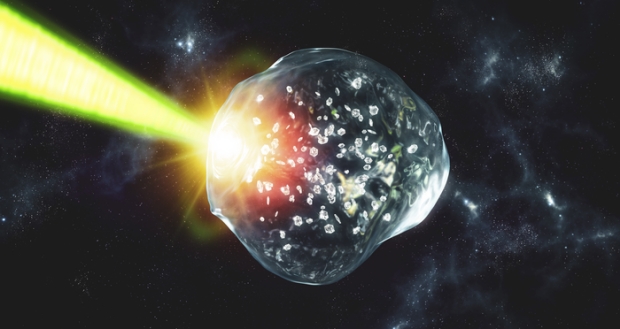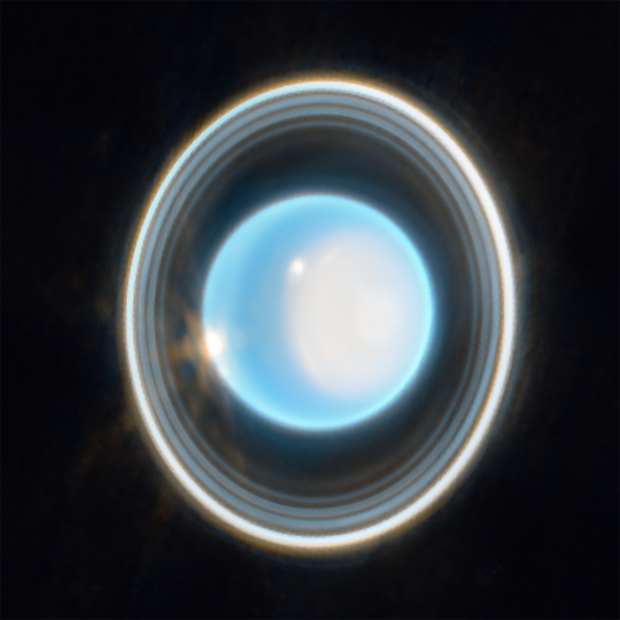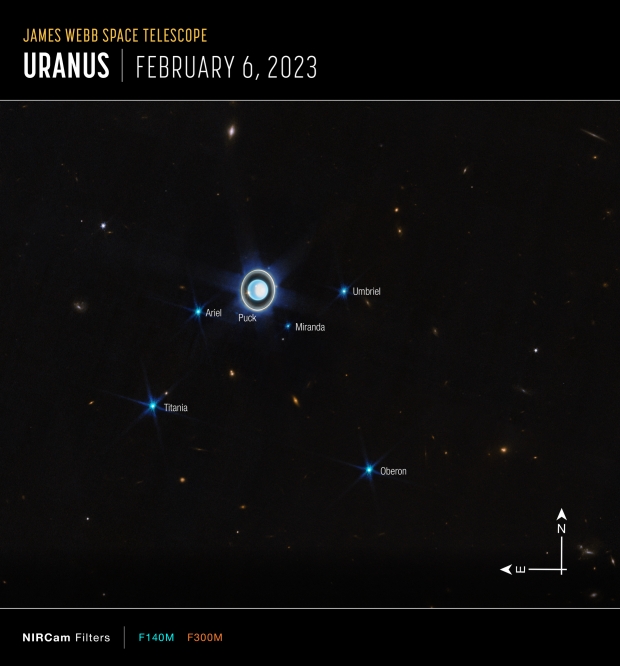Thinking about the ice giants, as I have been doing recently in our look at fast mission concepts, reminds me of the ‘diamond rain’ notion that has grown out of research into experiments with the temperatures and pressures found inside worlds like Uranus and Neptune. The concept isn’t new, but I noted some months ago that scientists at the Department of Energy’s SLAC National Accelerator Laboratory had been studying diamond formation in such worlds in the presence of oxygen. Oxygen, it turns out, makes it more likely that diamonds form that may grow to extreme sizes.
So let me turn back the clock for a moment to last fall, when news emerged about this exotic precipitation indicating that it may be more common than we had thought. Using a material called PET (polyethylene terephthalate), the SLAC researchers created shock waves within the material and analyzed the result with X-ray pulses. The scientists used PET because of its balance between carbon, hydrogen and oxygen, components more closely mimicking the chemical composition of Neptune and Uranus.
While earlier experiments had used a plastic material made from hydrogen and carbon, the addition of oxygen made the formation of diamonds more likely, and apparently allowed them to grow at lower temperatures and pressures than previously thought possible. The team, led by Dominik Kraus (SLAC/University of Rostock), suggests that such diamonds under actual ice giant conditions might reach millions of carats in weight, forming a layer around the planetary core. Silvia Pandolfi, a SLAC scientist involved in this work, was quoted in a SLAC news release last September:
“We know that Earth’s core is predominantly made of iron, but many experiments are still investigating how the presence of lighter elements can change the conditions of melting and phase transitions. Our experiment demonstrates how these elements can change the conditions in which diamonds are forming on ice giants. If we want to accurately model planets, then we need to get as close as we can to the actual composition of the planetary interior.”

Image: Studying a material that even more closely resembles the composition of ice giants, researchers found that oxygen boosts the formation of diamond rain. The team also found evidence that, in combination with the diamonds, a recently discovered phase of water, often described as “hot, black ice” could form. Credit: Greg Stewart/SLAC National Accelerator Laboratory.
Diamond rain is a startling concept, hard to visualize, and given the possibility that ice giants may be one of the most common forms of planet, the phenomenon may be occurring throughout the galaxy. Something to ponder as we look at the new image from Uranus just in from the James Webb Space Telescope, which highlights the planet’s rings as never before, while also revealing features in its atmosphere. The rings themselves have only rarely been imaged, but have been seen through Voyager 2’s perspective and through the adaptive optics capabilities of the Keck Observatory.
The brightness of the rings is striking, the result of the telescope’s Near-Infrared Camera (NIRCam) working through filters at 1.4 and 3.0 microns, shown here in blue and orange. The Voyager 2 imagery was as featureless as Voyager 1’s image of Titan, showing a lovely blue-green orb in visible wavelengths, but the power of working in the infrared is clear with the JWST results. Note the brightening at the northern pole (Uranus famously lies on its side almost 90 degrees from the plane of its orbit). This ‘polar cap’ formation appears when it is summer at the pole and disappears in the fall.

Image: This zoomed-in image of Uranus, captured by Webb’s Near-Infrared Camera (NIRCam) Feb. 6, 2023, reveals stunning views of the planet’s rings. The planet displays a blue hue in this representative-color image, made by combining data from two filters (F140M, F300M) at 1.4 and 3.0 microns, which are shown here as blue and orange, respectively. Credit: NASA, ESA, CSA, STScI. Image processing: J. DePasquale (STScI).
A few other features emerge here beyond the edge of the cap, including a second bright cloud at the left limb of the planet that seems to be related to storm activity. As to Uranus’ 13 known rings, 11 of them appear in the image. The other two, quite faint, are more visible, according to JWST scientists, during ring-plane crossings, which is a time in the planetary orbit when we see the rings edge-on. The Hubble instrument first discovered them during the last crossing, in 2007; the next will occur in 2049.
We’re dealing here with a brief exposure (12 minutes), but even so, a number of the planet’s moons can be found in the wider view shown below. Looking at this oddball system, I have to wonder whether the idea of a giant impact knocking it onto its side holds water. Can we get this result from resonance effects and the gravitational influence of the gas giants through periods of migration? The fact that the question can even be asked highlights how little we know about this particular ice giant. And whatever the cause, imagine a world where the Sun disappears for 42 years, a world of water, methane and ammonia, a rocky core and perhaps a rain of diamonds.

Image: This wider view of the Uranian system with Webb’s NIRCam instrument features the planet Uranus as well as six of its 27 known moons (most of which are too small and faint to be seen in this short exposure). A handful of background objects, including many galaxies, are also seen. Credit: NASA, ESA, CSA, STScI. Image processing: J. DePasquale (STScI).
As I’ve mentioned before, a mission to Uranus including an orbiter has been identified as a priority in the 2023-2033 Planetary Science and Astrobiology decadal survey. A flagship mission of Cassini-class at Uranus would be a great boon to science, but the suspicion grows that before it can fly, we’ll have learned how to reach the ice giants faster, and with mission strategies far different from those used for Cassini.
The paper on diamond rain is Zhiyu He et al., “Diamond formation kinetics in shock-compressed C?H?O samples recorded by small-angle x-ray scattering and x-ray diffraction,” Science Advances Vol. 8, Issue 35 (2 September 2022). Full text.



In “2061: Odyssey 3” (1987), Clarke posited that the implosion of Jupiter would create trillion-ton diamonds – of which Mt. Zeus on Europa became a plot device.
In a Wired Article sometime in the 1990s called The Diamond Age, cheap synthetic diamonds formed by vapor deposition were believed to upend the diamond market. It certainly panicked DeBeers, but so far, apart from jewelry, there have been no materials benefits such as diamond film protecting surfaces.
Now we have possible huge masses of diamonds formed in the atmospheres of the ice giants. If only they could be spat out into orbit. Perhaps a comet impact like Shoemaker-Levy on Jupiter could hurl diamond drops into orbit, waiting to be collected by robotic miners. What would the market be for “extraterrestrial diamonds”?
“What would the market be for “extraterrestrial diamonds”?”
nothing; they would be STRONGLY repressed to keep the price high
Phil Stooke @ Unmanned Spaceflight did a little processing on
the JWST image and brought out even more detail
http://www.unmannedspaceflight.com/index.php?showtopic=8465&view=findpost&p=260217
Come on NASA, wheres that flagship mission?
P
I have never been convinced by the giant impact theory, there are just too many unknowns and what we do know about impacts must call the idea into question.
Given that planets have been discovered orbiting stars at more that 60 degrees to the plane of the system we should consider whether such an occurrence happened in the early days of the solar system, if the Sun had a close encounter when a protostar the proto-planetary disk may have become warped, allowing planets and other bodies to form with high inclination orbits, over time, in the case of Uranus, gravitational forces from the gas giants and Neptune resulted in a more normalised orbit – but it retained its axial tilt in relation to the plane of its orbit.
An alternative, but far less likely scenario is that Uranus was captured – either from a passing star or because it was a rogue planet. The difficulties with either of these makes them extremely unlikely unless we envisage a ”sacrificial’ planet which was ejected from the solar system and thus allowing the capture to occur – far from impossible, far less likely.
If it was knocked over-diamonds circle it waiting for harvest
The reason we are most likely not about to get a Uranus orbiter despite the decadal recommendation is that JPL is overloaded from Mars Sample Return and Europa Clipper. The overload plus the pandemic caused the slip for Psyche which in turn has threatened VERITAS. The Planetary Society is trying to save VERITAS from cancellation. JHUAPL has less work, true, but I do not see a new start any time soon. I really wish that I am wrong
I agree. I was thinking of extraterrestrial diamonds being far more expensive per carat than mined diamonds, because of their “exotic” nature, like meteorites are far more expensive than terrestrial rocks. I don’t buy diamond jewelry, but I think those synthetic, gemstone-quality, diamonds are comparably just as expensive as the mined variety. They are supposedly even less flawed. The wealthy are always looking for items to brag about, and diamond jewelry from space might just be such an artifact.
However, if extraterrestrial diamonds proved cheap to acquire and deliver to Earth, as long as they did not threaten the jewelry market, but were used only for industrial purposes, such as creating scratch and corrosion-proof surfaces, then they might gain a large market.
Hard to visualize is an understatement! It’s not that surprising for diamonds to form at 5000 K and 100 GPa or more. But who’d have expected a “snowball’s chance” of finding ice there? Or hydrogen as a metal. Alright, so those were both known, but where the visualization really gets confusing for me is to picture superionic water ice – where H+ flows freely in a lattice of oxygen ions – in some equilibrium of oxygen concentration with liquid hydrogen metal with a solid lattice of protons and free-flowing electrons. Also, how different is this material from the electron-degenerate plasma in a cool white dwarf? I think in this environment, language truly fails me. But at what velocity could these diamonds “rain” down in such a place?